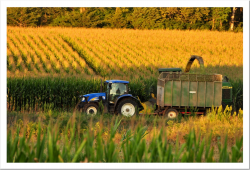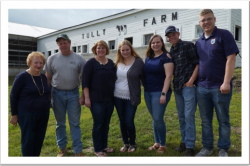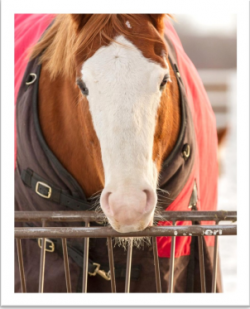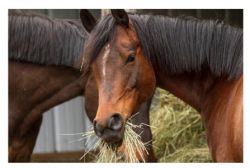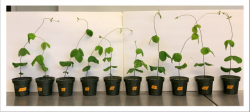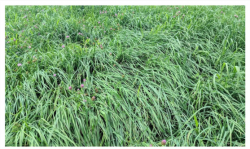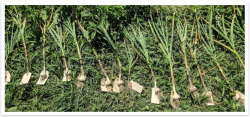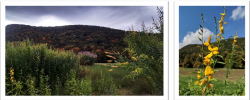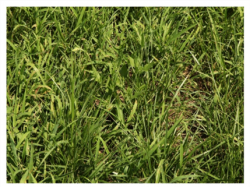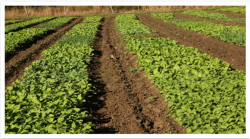Announcements
Corn Crop Insurance
Vegetable and Animal Field Day
Outstanding Dairy Award
Blanketing on Horses
Lapses in Access to Hay
Current Research Projects
NRCS Programs
Application Ranking Dates for NRCS programs
Alternative Forage Grant
Umass New Extension Director
Corn (Silage, Grain) Crop Insurance
Deadline: March 16, 2020
Farmers that grow corn for either silage or grain should start evaluating the type and level of coverage that meets their needs in 2020. There are many options in the type of coverage:
- Grain or Silage: These policies offer similar coverage. The insurance coverage attaches at the planting. Coverage ends when the crop is harvested or the final harvest date which is October 20th for silage or December 10th for grain.
- Yield or Revenue: The yield option uses the growers historical average yields to establish their 2020 yield. The revenue option uses both the average yield plus the established price. The grower’s revenue per acre is the average yield x price = revenue. Growers will receive both yield and market loss protection under this option. Growers can purchase 50% coverage up to 85% coverage under either option.
March 16, 2020 is also the deadline to make changes to an existing policy or cancel an existing policy. Crop insurance has many other options such as separate unit coverage, price selections, etc. Now is a good time to discuss all the options with your agent.
Crop insurance is sold and delivered through private crop insurance agents.
A list of crop insurance agents is available at all USDA Service Centers or on the RMA website at: https://www.rma.usda.gov/
Vegetable and Animal Field day
Date: July 15, 2020
Come and learn about exciting research projects!
Projects include:
- Termination types of cover crop & fertility
- New efficient weed control in cabbage and butternut squash using no till roller crimper
- Nutritional value of kohlrabi planted at different dates
- Growing vegetables under solar panel
- Fall and spring brewing barely testing trials
- And much more!
Duration: 10am—4pm
Location:
UMass Crop and Animal Research and Education Farm, 89 River Rd, South Deerfield, MA 01373
What is provided?
- Lunch
- Look into current innovative research
Now Accepting Nominations for the 2020 Massachusetts Outstanding Dairy Farmer Award
The 2019 winners of the Massachusetts Outstanding Dairy Farmer Award Tully Farm, 446 Pleasant Street, Dunstable MA.
The selection committee is accepting nominees for 2020. Please nominate a dairy farmer that you think is qualified for such an award by May 1, 2020. Self Nomination is welcome.
Selection will be based on the following criteria:
- Farm is operated by a full –time farmer with an efficient dairy operation
- Quality of dairy herd (milk production/cow, breeding program and herd health)
- Farm Efficiency (milk production/worker, other productivity considerations)
- The forage program (quality of forage as a well-balanced feeding program)
- Is the farm operation economically sound?
- Leadership ability (contributions at the local, regional, state, or national level)
- Contribution to environmental improvement (management, visibility, appearance, scenic aspects)
For more information, questions, or comments, please contact: Masoud Hashemi (413) 545—1843 masoud@umass.edu
Effect of Blanketing on Horse Surface Temperature
Summarized by Krishona Martinson, PhD, University of Minnesota.
From: February 2020 UMN Extension Horse e-Newsletter
Although horses are naturally able to adapt to most cold environments, many owners prefer to provide blankets for additional warmth and protection. There are a variety of blankets available; however, there are no standardized recommendations for use. Therefore, the objective of a recent study, conducted at North Dakota State University, was to examine changes in surface temperature of blanketed horses during cold weather.
Four mature stock-type horses were fitted with 3 different blanket weights (based on g of fiberfill), including light weight (0 g), medium weight (200 g), heavy weight (400 g), and a non-blanketed control. Thermographic images were obtained from a standardized lumbar location before blanketing and immediately after cold exposure. During cold exposure, horses were outside with ad libitum access to grass hay and water for 1 hour. Mean temperature was −9°F with a wind chill of −26°F. After 1 hour, horses were brought inside (59°F) and lumbar images immediately recorded.
Temperatures observed during the study were below the thermoneutral limit for cold adapted horses, but were indicative of the normal winter climate in the upper Midwest. Lower critical temperatures have been reported to be between 5°F and 41°F depending on age of the horse and hair coat. There was an overall blanket effect after horses were outside for 1 hour with lumbar temperatures measuring 72°F for horses without a blanket, 80°F for horses wearing a lightweight blanket, 86°F for medium weight, and 89°F for heavy weight blankets. Lumbar temperature was warmer for horses wearing the heavy weight and medium weight blankets compared with no blanket.
In conclusion, surface temperature along the lumbar area of horses decreased after exposure to cold temperatures. Addition of a blanket minimized or prevented the temperature decrease. However, horses were subject to short-term cold exposure. Exposure of blanketed horses to harsh winter climates for a longer period of time warrants further study. For more information
Ask the Expert: Lapses in Access to Hay
Author: Krishona Martinson, PhD, University of Minnesota.
From: February 2020 UMN Extension Horse e-Newsletter
Question: I run a boarding facility and my borders are concerned about the time between round bales. I know that horses should have hay in front of them 24-7. However, there are times where there might be a 6 to 8-hour gap between the horses finishing one round bale and feeding a new round bale. My boarders are concerned about ulcers due to this occasional gap in hay availability. All of the horses are trail horses, housed in a small herd outdoors (with a shelter), and are fed a ration balancer (no grain). I'd appreciate any assistance you could offer.
Response: It's a common misconception that horses need hay in front of them 24-7. What most horses actually need is about 2% of their bodyweight fed in numerous, small forage meals throughout the day. However, this is very challenging for most horse owners as few have the time or labor to achieve this. Round-bales are a common solution to providing basically unrestricted access to hay while reducing labor; however, some horses will over-consume hay and waste can be high when round bales are not fed in a feeder.
It's doubtful that an occasional lapse in hay access will cause any issues with ulcers, especially when the horses have basically 24-7 access to hay. Ulcer formation tends to be about more than just access to hay. Amount of grain fed, amount of turnout, show and training schedules, herd dynamics, access to water, medications (e.g. non-steroidal anti-inflammatory drugs), and even horse disposition can all play a role in the incident of ulcers. The incident of ulcer formation tends to be higher in horses fed larger amounts of grain, with limited turnout, under intense show or training schedules, and with more nervous dispositions. Since the horses are on full outdoor turn out with a round bale, are not fed grain, and are not under strenuous show or training schedules, it's unlikely they are at a high risk of ulcers, even with short gaps in hay access.
Current Research Projects
Hydrochar as a promising soil amendment By Anahita Khosravi
A greenhouse experiment is conducted to evaluate and compare the effects of hydrochar, Struvite, traditional P fertilizer and biosolid on growth and nutrients uptake of corn and soybean. Also, soil phosphorus and nitrogen leaching will be studied.
Winter Rye Termination and Sweet Corn By Arthur Siller
Winter rye and red clover cover crop will be terminated using herbicides, tillage, and roller crimper to explore soil ecology and weed control over two years of sweet corn production. Different levels of nitrogen fertilizer will be tested to examine how the cover crop effects summer soil fertility.
Stockpile By Arthur Siller
Fescue and orchard grass pastures have been established in South Deerfield MA to investigate the best management practices for stockpiling forage in the fall. We are exploring when summer grazing should stop and how nitrogen can be supplied (through fertilizers or legumes) to produce high quality forage.
Brassicas and Summer Annuals By Arthur Siller
Annual forage mixtures will be grown over the next two years at several locations in New England to investigate the use of new cropping systems to climate change predictions for livestock production. Mixtures will focus on filling forage production gaps in the middle of summer and late fall and the trials will focus on species compatibility in mixtures and overall forage quality.
Impact of Planting Date and Soil temperature on Kohlrabi By Alexandra Smychkovich
A two-year experiment investigating the impacts of spring planting date and soil temperature on kohlrabi yield and nutritional qualit
Decomposition trends of ‘Green Manure’ By Alexandra Smychkovich
This project documents the decomposition trends of 'green manure' in the form of spring planted faba bean residues (roots and shoots), composted cow manure, and composted chicken manure and eggshells. Decomposition rate, compost nutrient release, and nutrient uptake by a successor crop will be documented over the course of eight weeks.
Innovative Northeast Garlic production Method By Alexandra Smychkovich
This project investigates the benefits and feasibility of an innovative garlic production method in the northeast. In the proposed system, garlic is planted into standing fall planted cover crops (mono-culture and mixed species) and inoculated with arbuscular mycorrhizal fungi (AMF) at time of planting. This project will quantify the nitrogen contribution of decomposing cover crop residues to sprouting spring garlic, the impact of AMF on garlic water and nutrient uptake efficiency, and the influence of each treatment on the yield and nutritional quality of garlic. Additionally, soil health characteristics will be assessed for each treatment as well as soil food web structure and stability as residues decompose.
Sunn Hemp By Sam Corcoran
Sunn hemp, (Crotalaria juncea), is a tropical legume of increasing interest in the Northeast. At UMass, we have been researching this legume cover crop since 2014. Sunn hemp is an amazing nitrogen fixer that offers rapid growth; it is also very drought tolerant and thrives in the heat. In the crippling drought of 2016, our sunn hemp plants thrived and reached heights of 12 feet in 90 days. In MA, we have found that the plants can produce as much as 250 lbs. of nitrogen/acre in their aerial biomass alone. This summer we will complete our third and final year of a field research study that assess the ideal planting date of sunn hemp in a northeastern climate as well as the potential of the plant to provide weed suppression. We are continuing to assess the nitrogen fixing capacity of this crop, and we will soon move towards testing ways to most effectively process sunn hemp so that it can be stored for fertilizer and applied as needed. We like to say you can grow your own fertilizer!
Thinking of planting sunn hemp this summer? We currently recommend planting in early to mid-July for maximum biomass production. Plants do not establish well if they are planted before this time unless it is an exceptionally warm year. If July is too early to fit into your rotation, sunn hemp will do well planted through mid-august. The plant is very responsive to temperature and day length. The later you plant, the shorter the plants will be (and the less biomass and nitrogen they will amass) when they begin to flower and cease growth. Want more details or suggestions about growing this amazing cover crop? Please feel welcome to contact Sam Corcoran at sglazecorcor@umass.edu.
NRCS Financial Assistance Programs
- Environmental Quality Incentives Program (EQUIP)
EQIP provides financial and technical assistance to agricultural producers in order to address natural resource concerns and deliver environmental benefits such as improved water and air quality, conserved ground and surface water, reduced soil erosion and sedimentation or improved or created wildlife habitat.
More info: https://www.nrcs.usda.gov/programs-initiatives/eqip-environmental-qualit... - Conservation Stewardship Program (CSP)
The Conservation Stewardship Program helps agricultural producers maintain and improve their existing conservation systems and adopt additional conservation activities to address priority resources concerns. Participants earn CSP payments for conservation performance—the higher the performance, the higher the payment.
More info: https://www.nrcs.usda.gov/programs-initiatives/csp-conservation-stewards... - Agricultural Management Assistance Program (AMA)
AMA helps agricultural producers use conservation to manage risk and solve natural resource issues through natural resources conservation. NRCS administers the AMA conservation provisions while the Agricultural Marketing Service and the Risk Management Agency implement other provisions under AMA.
More info: https://www.nrcs.usda.gov/programs-initiatives/ama-agricultural-manageme...? cid=stelprdb1249913
For more information, contact your local USDA-NRCS office:
- Greenfield field office – 413-772-0384, ext 3, serving Franklin County
- Hadley field office – 413-585-1000, ext 3, serving Hampden and Hampshire counties
- Holden field office – 508-829-4477, ext 3, serving Worcester County
- Pittsfield field office – 413-443-1776, ext 3, serving Berkshire County
- Westford field office – 978-692-1904, ext 3, serving Essex, Middlesex and Suffolk counties
- Wareham field office – 508-295-5151, ext 2, serving Bristol, Norfolk and Plymouth counties
- West Yarmouth field office – 508-771-6476, serving Cape Cod and the Islands
Application ranking dates for conservation programs
From the Natural Resource Conservation Service
USDA announces 2020 application ranking dates for conservation programs. March 20th is next ranking cut-off date.
AMHERST, Mass. Feb. 28, 2020 – Do you own or manage farmland or forest land in Massachusetts? Could you use some technical and financial help in managing it more effectively? The U.S. Department of Agriculture’s Natural Resources Conservation Service (NRCS) encourages you to sign up for conservation assistance through the Environmental Quality Incentives Program (EQIP) and Agricultural Management Assistance program. Applications may be submitted at any time during the year; however, the next ranking batching date will be March 20, 2020.
You may apply for NRCS conservation programs at any time; complete applications are ranked for funding in batches periodically throughout the year. All applications determined eligible and high priority by close of business on the ranking date will be considered in the current funding cycle.
The following application ranking dates, pending available funds, are scheduled:
- March 20, 2020
- April 17, 2020
- May 15, 2020
- June 19, 2020
- July 17, 2020
- August 21, 2020
Ranking dates and the application process are subject to change. Contact your local field office for the latest information. For more information on available programs, the application process, and natural resource priorities, visit the Massachusetts NRCS website at https://www.nrcs.usda.gov/conservation-basics/conservation-by-state/mass...
“If you operate a farm or manage forest land and want to improve your land, we can help,” said Dan Wright, State Conservationist for NRCS in Massachusetts. “You can discuss your vision for your land with one of our conservation planners, who will explain the conservation planning process and how to apply for financial assistance.”
MEDIA CONTACT: Diane Petit, Public Affairs Specialist, 413-253-4371, diane.petit@usda.gov
Alternative Forage Grant: Strategies for extending grazing season and Profitability in Dairy and Livestock Operations in New England
By Masoud Hashemi and Arthur Siller
Grazing is the most cost-effective method to feed livestock in New England, saving as much as $1.30/animal/day through lower cropping costs, lower housing and herd management expenses, and increased animal longevity. Unfortunately, grazing has been limited regionally due to decreased plant growth during summer slump and slow/no growth after early frosts.
Recently a collaborative project by researchers from MA, VT, and ME have received funding from Northeast Sustainable Agriculture Research and Education (SARE) to investigate several novel extended grazing systems to increase forage inventory, farm profits, and climate adaptability in the immediate future and over the next decades. These strategies will provide research and education to help dairy and livestock farmers to confidently increase forage yield and quality and replace stored or purchased feeds. Using a minimum value of $60 per 800 lbs dry round hay bale, we estimated the economic impact per acre of the following strategies:
Firstly, for fall stockpile grazing, we estimated 8” of available forage produces 225 lbs dry matter per inch per acre (1,800 lbs) which can support a cow of 800 lbs. considering a daily intake of 3% of body weight, this amount of forage is sufficient for at least 75 days/animal, equal to $135 worth of stored feed/acre.
The second strategy is to no-till drill cereal rye into existing pastures in August when pastures are not growing. Rye is very cold-tolerant and continues growing well into late November, allowing grazing in late fall or early spring. Our previous research indicated that rye planted in September can produce a minimum of 3,000 pounds dry matter/acre in late fall when grown alone. We anticipate that planting rye one month earlier i.e. August can compensate for some potential competition from the existing pasture. We anticipate harvesting 2,500 pounds/acre dry matter which is equal to $185/acre.
Thirdly, we will plant mixed summer annuals that potentially can be grazed two times. Research in Vermont in 2017 have shown that mixed summer annuals can produce as much as 5,700 pounds dry matter/ acre equal to $425/acre. By exploring this strategy, we will evaluate regrowth and forage quality over the summer in order to make management recommendations.
Alternative Forage Grant: Strategies for extending grazing season and Profitability in Dairy and Livestock Operations in New England
By Masoud Hashemi and Arthur Siller
Finally, 15-20 brassicas species will be grown as cold tolerant forage to extend grazing of livestock in the fall. Trials in Vermont indicated that brassicas could produce around 3,000 pounds dry matter/acre equal to $225/acre.
These innovative strategies will provide opportunities for animal operations to diversify their forage production on their farm with reliable cropping options to increase the resiliency of their farm businesses and thus increase the food security and environmental adaptability of our region.
Director of UMass Extension Agriculture Program: Clem Clay
Clem Clay is the new Director of the UMass Extension Agriculture Program. He was previously Executive Director of Grow Food Northampton, a non-profit that strengthens the local food system by leasing land to farmers, managing farmers’ markets and a community garden, operating numerous food access programs for low-income residents, and providing farm-based and classroom education for thousands of students. Previously, he spent 10 years as Program Director for the Trust for Public Land, managing Connecticut River and Community Agriculture programs and helping to obtain over $6 million in public and private funding to help landowners conserve hundreds of acres of land. He grew up in Vermont helping with family maple and sheep operations, and spent time in his early career as a small-scale vegetable farmer in Vermont and farmers’ market manager in California. At UMass, Clem oversees Extension educators in production agriculture and commercial horticulture, as well as the Soil and Plant Nutrition and Plant Pathology labs. Clem has a Master’s degree in public policy and administration from UMass and a Bachelor’s in the Soil Environment from UC Berkeley.
